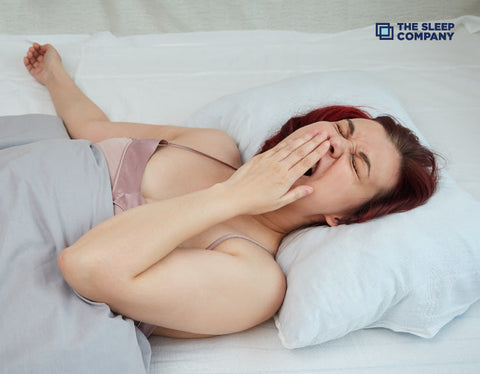My Cart

Maladaptive Daydreaming - Tests, Treatment & Symptoms

Losing yourself in an exciting daydream is quite common. Infact, our minds have a tendency to wander about 46.9% of the time.
That said, 2.5% of adults go through an excessive form of daydreaming, known as maladaptive daydreaming.
These daydreams are said to be vivid fantasies that can even interfere with your day-to-day life.
Ahead, we will walk you through everything you must know about maladaptive daydreaming and how you can control it. Let's get started!
What Is Maladaptive Daydreaming?
Maladaptive daydreaming is a condition where you experience intense or vivid movie-like daydreams that interfere with your day-to-day life. These daydreams feel extremely real and you may lose yourself in them for hours in a day.
With maladaptive daydreaming, these daydreams become a part of your life and you even tend to form emotional attachments to these fantasies. These fantasies can be triggered by emotions, music, or repetitive actions.
Suffering from maladaptive daydreaming makes it difficult for you to focus on your work and studies.
Maladaptive Daydreaming Symptoms
Here are some of the maladaptive daydreaming symptoms;
- Intense daydreams
- Vivid fantasies
- Daydreams that are hard to control
- Spending hours daydreaming
- Getting emotionally attached to fantasies
- Unable to or facing difficulty in focusing on real-life
- Daydreams that are triggered by music, boredom, etc.
- Feeling extreme guilt or frustration against daydreaming
- Avoiding social interactions for daydreaming
- Feeling detached from reality
Who Is at Risk of Maladaptive Daydreaming?
People at risk of developing maladaptive daydreaming are:
- Individuals with a traumatic past
- People who don't go out much or have a limited social circle
- Individuals who feel lonely or isolated
- Highly creative individuals
- Those who use daydreaming as a coping mechanism
- People struggling with mental health issues like stress and anxiety
Is It A Common Condition?
No, maladaptive daydreaming is not very common, and about 2.5% of people experience this condition. Today, thanks to the growing research and studies, it is being recognized as a mental health issue.
Complications of Maladaptive Daydreaming
In the beginning, daydreaming may seem like a sweet escape. But when this becomes a regular habit where you find solace in your fantasies, it can interfere with real life. Too much of anything can be addictive and dangerous.
Maladaptive daydreaming makes it difficult for you to focus on work, studies, or even maintain relationships. Over time, it can lead to mental health issues and can cause stress and anxiety. This is why it is important to identify the symptoms and come up with a treatment plan to overcome this issue.
Maladaptive Daydreaming Diagnosis
While maladaptive daydreaming is a mental health issue, it isn't officially recognized as a medical condition, so there’s no standard diagnosis. However, your doctor may use self-help tools, such as the Maladaptive Daydreaming Scale (MDS) to understand your symptoms.
Your doctor will also understand your symptoms and identify patterns for a robust treatment plan.
Maladaptive Daydreaming Treatment
Here's how to stop maladaptive daydreaming. These tips can help you combat them to a great extent.

- Cognitive Behavioural Therapy
- Mindfulness Practices
- A Regular Sleep Schedule
- Grounding Techniques
- Exposure To Sunlight
- Improve Quality Of Sleep
- Understanding Triggers and Symptoms
- Channeling Imagination Productively
- Building Supportive Relationships
- Therapy and Professional Help
1. Cognitive Behavioural Therapy
Cognitive behavioral therapy or CBT is a type of talk therapy where you can identify and change harmful thought patterns and behaviors. And, CBT can be a useful tool in helping you manage maladaptive daydreaming.
This treatment method helps you identify triggers and come up with healthier coping mechanisms. It also helps you with practical ways to regain focus and stay present in reality. For this, you can speak with a mental health professional today.
2. Mindfulness Practices
Mindfulness is a practice where you train your mind to stay in the present. This helps you overcome your vivid daydreams and take control of the now.
To get into mindfulness, you can try meditation or deep breathing exercises. Doing this regularly will help you develop better awareness and control your thoughts.
3. A Regular Sleep Schedule
Something as simple as building a regular sleep schedule can help you combat maladaptive daydreaming. This is because poor sleep can increase daydreaming tendencies.
Therefore, stick to a proper sleep schedule. Wake up and go to bed at the same time, even on weekends. This small trick is how to control maladaptive daydreaming as it improves your sleep quality. A good night's rest keeps you refreshed during the day and reduces the mental fog.
4. Grounding Techniques
Like mindfulness, grounding techniques help you bring your focus back to the now. To practice grounding, simply focus on your senses. For example, name five nearby objects you can see, hear, smell, and feel.
This can break the cycle of daydreaming and anchor you to reality when you feel distracted. Whenever you feel the urge to slide into daydreams, use this trick.
5. Exposure To Sunlight
Getting 15 minutes of sunlight every morning can be extremely beneficial because it regulates your sleep-wake cycle. This means, you are able to fall asleep and wake up without any hassles, which can improve your sleep quality.
On the other hand, sunlight also helps improve focus and reduces the emotional need for escape. It becomes easier to manage daydreaming tendencies naturally.
6. Improve Quality Of Sleep
A good night's rest can solve many problems and can also help you with maladaptive daydreaming. Better sleep gives you mental clarity and keeps your emotions in check.
That's why it is essential to have a comfortable sleep environment. Start with a cozy mattress that supports you throughout the night. You need something that won't disrupt your sleep and let you snooze peacefully. Next, invest in proper pillows and bedding as well. Make sure it aligns with your comfort needs.
You can also make sure the room is cool and dark to improve sleep quality. And, if you are someone who struggles with sleep, opt for comforting habits before bed. It can be journaling, listening to soothing music, etc.
7. Understanding Triggers and Symptoms
Maladaptive daydreaming can occur due to certain triggers. It can be a particular music, stress, or even boredom.
Therefore, recognize your triggers, and the root cause. This makes it easier for you to combat them. For example, if a song leads you to slip into vivid daydreams, you can avoid listening to it.
8. Channeling Imagination Productively
Since your imagination is vivid and vibrant, why not take advantage of it? Channel your daydreams into something productive. You can redirect your creative energy into writing, drawing, composing music, and whatnot!
Remember, productive outlets turn daydreaming into something rewarding and constructive.
9. Building Supportive Relationships
It's time to replace maladaptive daydreaming with real-life connections. Make new friends, reconnect with old ones, talk and mingle with your family. Do what needs to be done to create supportive relationships.
When you have people to talk to and confide in, people who can help you feel less lonely, it becomes easier to let go of your daydreaming.
10. Therapy and Professional Help
If you are struggling with maladaptive daydreaming, you can always talk to a mental health professional.
They can help you with the right course of treatment and can uncover deeper issues that cause daydreaming. A professional will even help develop better coping skills and curate a recovery plan for long-term success.
Conclusion
While there is no standard treatment and cure for maladaptive daydreaming, it doesn't mean you cannot combat the condition.
Following the above-mentioned tips can provide relief and help you come out of your complicated fantasies.
Remember, you can stop letting yourself get trapped in these highly structured scripts and come out of them a winner by developing healthy sleep habits.
Make sure you have a proper sleep schedule and opt for a set of relaxing activities before bed. Also, build a comfortable sleep environment, starting with a supportive and cozy mattress.
The Sleep Company makes it easy for you to enjoy the best sleep experience with a range of mattresses, pillows, and bedding. Designed for perfect sleep, our products blend science and luxury so you wake up refreshed, every day!
Transform your slumber with The Sleep Company today!
FAQs
Maladaptive daydreaming is a condition where you experience intense, vivid daydreams that interfere with your everyday life. It’s often seen as a way to escape reality or cope with stress.
Some of the common symptoms of maladaptive daydreaming are excessive daydreaming, trouble focusing on tasks, difficulty controlling daydreams, emotional attachment to fantasies, and spending hours lost in imaginary worlds.
We still don't know the exact cause that leads to maladaptive daydreaming. But it’s usually linked to trauma, anxiety, loneliness, or stress. Daydreaming becomes a coping mechanism to escape negative emotions or challenging realities.
No, there are no official medical tests for maladaptive daydreaming. However, there are self-assessments like the Maladaptive Daydreaming Scale (MDS) to identify symptoms. You can also consult a mental health professional for proper evaluation.
There’s no specific medication for it. However, your doctor will be able to guide you in the right direction by treating the underlying causes. For more, make sure you speak with a mental health professional today.

































































